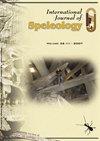新冠肺炎疫情下展区基础设施的安全有效消毒
IF 1.3
4区 地球科学
Q3 GEOSCIENCES, MULTIDISCIPLINARY
引用次数: 4
摘要
由新型冠状病毒SARS-CoV-2引起的COVID-19大流行已导致全球65万多人死亡。SARS-CoV-2的传播主要是通过空气传播或直接人际接触,这表明了保持社交距离措施和使用口罩预防感染的重要性。尽管如此,冠状病毒在物体表面的持续存在意味着消毒对于限制接触传播的可能性非常重要。在本文中,研究了洞穴中各种表面作为SARS-CoV-2感染源的可能性。考虑到SARS和类SARS冠状病毒的等电势(pI),它们很可能通过电化学相互作用吸附到(石灰石)岩石表面,那里的高湿度、pH值和生物碳酸盐离子的存在将迅速导致失活。尽管如此,洞穴中包含由其他无孔表面构成的基础设施,这些表面更有利于维持冠状病毒的生存能力。美国环境保护署(EPA)批准的423种抗病毒产品被整理成23种抗病毒化学物质,并根据其潜在的危险性、对洞穴特征或生态系统的影响以及对洞穴影响最小的化合物进行进一步分类。结果表明,酒精(70%乙醇)、有机酸(柠檬酸和乳酸)和稀次氯酸盐是洞穴内非多孔表面消毒的最佳消毒剂。这些消毒剂能够灭活生态系统中的冠状病毒。本文章由计算机程序翻译,如有差异,请以英文原文为准。
Safe and effective disinfection of show cave infrastructure in a time of COVID-19
The COVID-19 pandemic, caused by the novel coronavirus SARS-CoV-2, has been responsible for over 650,000 deaths worldwide. Transmission of SARS-CoV-2 occurs primarily through airborne transmission or direct human contact, demonstrating the importance of social distancing measures and the use of face masks to prevent infection. Nonetheless, the persistence of coronavirus on surfaces means that disinfection is important to limit the possibility of contact transmission. In this paper, the potential for various surfaces in show caves to serve as sources for SARS-CoV-2 infection is examined. Given the isoelectric potential (pI) of SARS and SARS-like coronaviruses, it is likely that they are adsorbed via electrochemical interactions to (limestone) rock surfaces, where the high humidity, pH and presence of biocarbonate ions will quickly lead to inactivation. Nonetheless, show caves contain infrastructure made of other non-porous surfaces that are more permissive for maintaining coronavirus viability. The 423 antiviral products approved by the US Environmental Protection Agency (EPA) were curated into 23 antiviral chemistries, which were further classified based on their potential to be hazardous, impact cave features or ecosystems, and those compounds likely to have the minimum impact on caves. The results suggest that alcohols (70% ethanol), organic acids (citric and lactic acid) and dilute hypochlorite represent the best disinfectants for in-cave use on non-porous surfaces. These disinfectants are able to inactivate coronaviruses inecosystems.
求助全文
通过发布文献求助,成功后即可免费获取论文全文。
去求助
来源期刊

International Journal of Speleology
地学-地球科学综合
CiteScore
3.10
自引率
23.10%
发文量
12
审稿时长
>12 weeks
期刊介绍:
The International Journal of Speleology has the aim to get cave and karst science known to an increasing number of scientists and scholars. The journal therefore offers the opportunity to all scientists working in and on karst to publish their original research articles or their review papers in an open access, high quality peer reviewed scientific journal at no cost. The journal offers the authors online first, open access, a free PDF of their article, and a wide range of abstracting and indexing services.
 求助内容:
求助内容: 应助结果提醒方式:
应助结果提醒方式:


